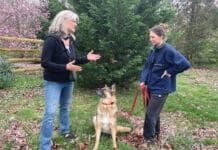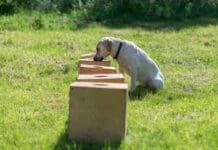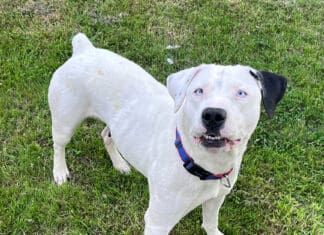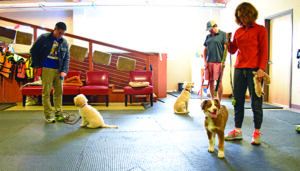
Those of you who have just emerged from your first-ever group dog obedience training class have my sympathies. For the unprepared, that experience can be a rude awakening.
Whether your pup is pulling wildly toward the other dogs, acting like she’s never met you, barking while the instructor talks, or hiding under your chair, the first class may feel like a nightmare. In fact, you may be tempted to tell people this is actually your neighbor’s dog and you’re just pitching in.
After that kind of introduction, many dog owners listen to the little voice in their head whispering, “Let’s just forget we paid for all six lessons and call it a day.” That’s a shame, because when humans stick with it, they often walk out of Class #6 stunned at the turnaround they’ve experienced.
To help make sure you get to that magic day, the best programs have a surprising rule for Class #1: No Dogs Allowed. During that key first hour, blissfully free of doggy distractions, the instructors set up the humans for success. They set appropriate expectations and give some make-or-break tips on how to manage your dog during class.
If your upcoming class doesn’t offer that dog-free first class, make yourself a nice cup of tea, sit down in your quiet kitchen, and absorb these five survival tips before you head into the joyful chaos that is Doggy 101.
1. Bring your sense of humor and reasonable expectations.
Sometimes the secret to life is low expectations, and that is dramatically true here. Assume the first class or two will feel ridiculously hard. Be thrilled if anything goes right! Getting your head in this generous space is key, because the more stress you bring into that training area, the more your dog will feel it. Take a deep breath, and don’t lose your sense of humor.
Keep in mind that this is not a competition. If your dog is the most disruptive in the class, don’t shrink in embarrassment. Instead, find the warmest fellow student so you can share a smile about it. Then remember that this means you have the greatest potential for the most improved award after six weeks!
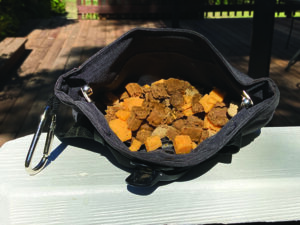
2. Use amazing dog treats.
Know this: The same dog who sits and stays beautifully for you in your kitchen will act as if he does not even hear you in class. With the explosion of distractions – a different space, other dogs, and new people – you’re going to need help drawing your dog’s attention back to you. Put serious thought and prep into surprising your new student with fabulous dog treats in class, linking the first training experience with this giant positive. Think dried fish, liver, cheddar cheese, fresh chicken.
Also: Bring more food than you think you’ll need. First-time students always run out! You’ll be asking your dog for many behaviors in this hour, and you need to be ready to reward. You’ll be using tiny pieces (the size of a pea), but it adds up. This all means you need an official treat pouch. That Baggie in your pocket is going to be way too clumsy to work with.
(Oh, and yes: This talk about food reveals that I assume you have followed both the very strong science and your good heart, and have sought out a trainer who is committed to positive reinforcement.)
3. Start in the parking lot.
You’re going to drive up to class with a treat pouch packed with terrific treats and ready to go. The next little secret is to let your dog or pup in on this news the minute you get out of the car. Wave that tiny piece of ham past his nose and ask for a quick moment of attention – and reward it when it happens. Your newly focused-on-you pup thinks, “Wow! What is happening?!”
As you continue to walk in, ask for any behaviors that are solid at home – perhaps sit, or shake, or a look in response to his name. As your pup revels in his sudden ability to snag some previously unheard-of treats just by listening a bit, you’re walking successfully past the dogs and people who might have been a crazy distraction before.
Do that every time you come to class, and soon you’ve built a pattern. You’re the most reliably rewarding thing in your dog’s life, even when you’re out and about. Get ready for some very nice attention to follow.
4. Expect to miss some instruction.
During class, be ready to keep on working hard just managing your dog. Don’t worry if that means you miss a bit of what’s being said! You may find it helps to present your pup with a new chew like a bully stick so that you can listen to the instructor as she explains the next exercise. If your pup is slightly more advanced, you can quietly ask for (and reward!) sits, touches, and looks while the trainer is talking.
“Wait, how am I supposed to listen if I’m busy with toys and management?” I hear you. It is frustrating. But even if you have to work so hard on managing your wild creature that you barely absorb the official goings-on, this experience can be a fantastic hour for your pup. You’re out of the house, and pup is seeing the world. And if you’re staying cool and positive, then it’s bonding time for the two of you. Next time, it’ll be easier, and the time after that, even more so. Just keep your head in the right place and keep on coming!
5. Do your homework!
While we humans are working our bums off during class, our dogs are maybe, sort of, halfway learning a thing or two. The truth is that what’s really happening in that class is that humans are learning how to teach various behaviors effectively. It’s the at-home practice that results in your dog truly learning the behaviors.
Carve out a few minutes a day to practice exactly what you did in class. Do it in the kitchen, progress to the backyard, then take the big step to the distraction-filled front yard. Be ready to be amazed at 1) how much your dog adores this time with you, and 2) how incredibly smart your pup is.
One of the best ways to make your at-home training more effective is to ask somebody else to take a few quick videos of you working together. (Or just prop your phone up at the right angle and record!) Even dog trainers catch themselves making mistakes that way! Look closely, find that misstep, and watch how your results change. You may well find yourself addicted to noticing tiny improvements each week.
Obviously, I’m a big fan of a well-run group class. I offer private, in-home training, but I encourage all of my clients to also find a class, and here’s why:
- Those distractions that are so challenging at first end up being gold in terms of teaching your dog to focus in any environment.
- You learn so much from watching other teams work together.
- You gain perspective when you see everybody else’s strengths and weaknesses.
- Both you and your dog make friends – which can start with funny commiseration and build into great playdates, joint walks, and even pet-sitting trades.
Finally, yet another bonus to group class: You’ll have an audience of witnesses to cheer the fact that you’ve really come a long way from that first crazy day!


